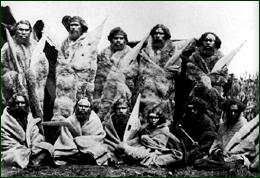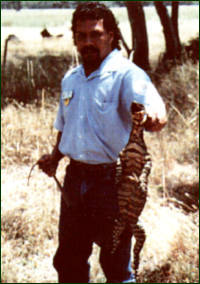| |
Two
important occupations of Gariwerd/The Grampians are recorded in
the more recent history of the area. Firstly Aborigines (or Koori)
activity in Gariwerd/Grampians dates as far back as 22,500 years
ago. The tribes that lived in the area were Djab Wurrung and the
Jardwadjali. The mountains provided a spectacular backdrop for
hunting and gathering resources prior to migrations north, east
and west. As hunters-gatherers, the Aborigines took only what
they needed to prepare themselves for the journeys from site to
site. However, the Kooris of Gariwerd were involved in "farming"
of eels and built immensely complex channels below the southern
slopes where they trapped the eels.
Aborigines are custodians rather than owners of the land and were
careful to preserve it for their future use. The Aborigines did
make a vast change to the Australian landscape and ecology through
simple but effective technology. Many sacred sites and "factories"
(where tools were made) were established in the Rock Shelters
which are so prevalent in the ranges, and it is from these that
we can gather valuable information about early habitation.
In the south of Gariwerd are some constructions which are unique
in Australia. Kilometres of complex channels were carved using
simple digging sticks to direct eels into nets, which were then
cooked in large earth ovens. The eel catching was an important
ceremonial time and neighbouring family groups would gather for
the feasting. Fishing was not confined to this method. Long flexible
rods with string made from bark had worms tied to them for angling
and large nets were used for trolling shallow waters. Fruits,
berries, seeds and roots were also gathered, forming the staple
part of the Koori diet. However, it wasn't all food gathering.
This area constitutes the most important art sites in south east
Australia, with some 276 recorded sites (only about five are opened
to the public). Shelters show signs of deterioration through the
ages, but mostly because of senslesss vandalism. This has prompted
the authorities to fence off the areas which now remain open to
the public. The artwork can never be replaced. The earliest known
paintings were done 22,500 years ago and the latest ones 5,000
years ago.
Courtesy
of:
The Brambuk Aboriginal Cultural Centre
For
more information on Aboriginal Heritage:
Aboriginal
Heritage
Aboriginal
Rock Art
Brambuk
Aboriginal Cultural Centre
European
Settlement
The Yardwadjali and Djap Wurrung Story
Back to Top
|
|

Dignified
band of Victorian Aboriginal people, photographed by A. J. Fauchery
in 1858. (Museum Victoria)

Education
Officer Warren Meeks with a goanna he has caught for roasting at
a tradtional tucker camp in Gariwerd.
|